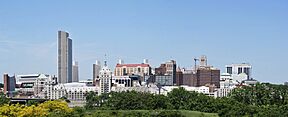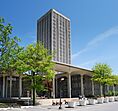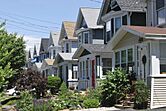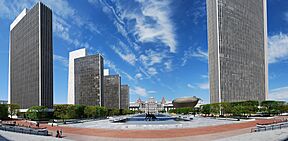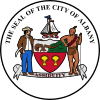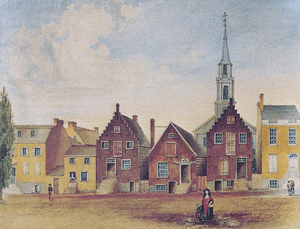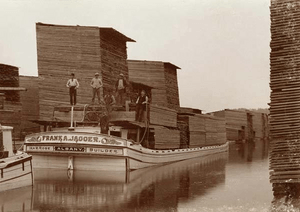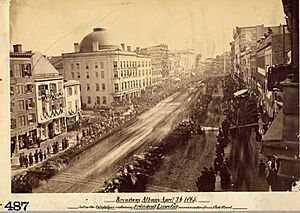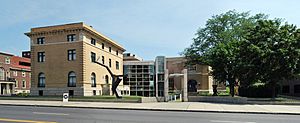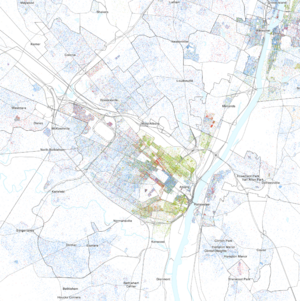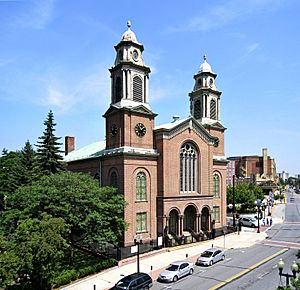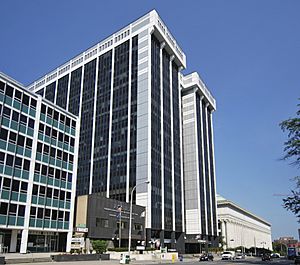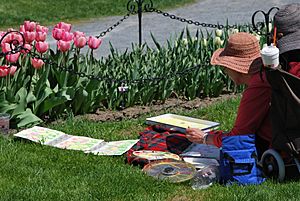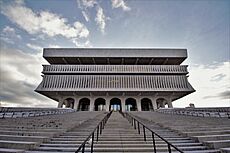Albany, New York facts for kids
Quick facts for kids
Albany
(Mohican: Paupautanwuthyauk) |
|||||
|---|---|---|---|---|---|
|
Downtown Albany skyline from Rensselaer
State Quad at SUNY Albany
Empire State Plaza from the Cultural Education Center
|
|||||
|
|||||
| Etymology: Named for the Scottish Duke of Albany, whose title comes from the Gaelic name for Scotland: Alba | |||||
Nicknames:
|
|||||
| Motto(s):
Assiduity
|
|||||
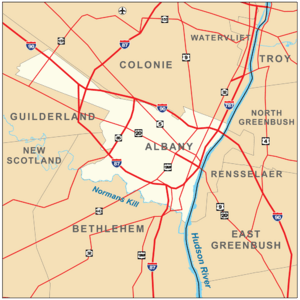
Boundaries of and major thoroughfares through Albany
|
|||||
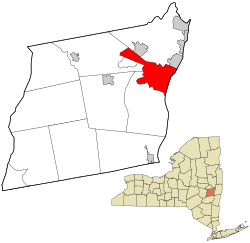
Location of Albany in Albany County (upper left) and of Albany County in the State of New York (lower right)
|
|||||
| Country | United States | ||||
| State | New York | ||||
| Region | Capital District | ||||
| County | Albany | ||||
| Settled | 1614 | ||||
| Incorporated | 1686 | ||||
| Government | |||||
| • Type | Strong mayor-council | ||||
| Area | |||||
| • State capital | 21.94 sq mi (56.81 km2) | ||||
| • Land | 21.40 sq mi (55.44 km2) | ||||
| • Water | 0.53 sq mi (1.38 km2) | ||||
| • Metro | 2,811.6 sq mi (7,282 km2) | ||||
| Elevation | 148 ft (45 m) | ||||
| Highest elevation | 378 ft (115 m) | ||||
| Lowest elevation | 2 ft (0.6 m) | ||||
| Population
(2020)
|
|||||
| • State capital | 99,224 | ||||
| • Estimate
(2023)
|
101,228 (US: 331st) | ||||
| • Density | 4,730.28/sq mi (1,825.9/km2) | ||||
| • Urban | 593,142 (US: 73rd) | ||||
| • Urban density | 2,186.3/sq mi (844.1/km2) | ||||
| • Metro | 1,170,483 (US: 63rd) | ||||
| • Metro density | 416.3/sq mi (160.7/km2) | ||||
| Demonym(s) | Albanian | ||||
| Time zone | UTC−5 (EST) | ||||
| • Summer (DST) | UTC−4 (EDT) | ||||
| ZIP Codes |
12201–12212, 12214, 12220, 12222–12232
|
||||
| Area codes | 518, 838 | ||||
| Geocode | 977310, 978659 | ||||
| ISO 3166 code | 36-01000 | ||||
| FIPS code | 36-01000 | ||||
| GNIS feature ID | 977310 | ||||
Albany (![]() i/ˈɔːlbəni/ awl-BƏ-nee) is the capital city of New York State. It is the oldest city in the state and the main city in Albany County. Albany is located on the west bank of the Hudson River, about 10 miles (16 km) south of where the Hudson and Mohawk Rivers meet.
i/ˈɔːlbəni/ awl-BƏ-nee) is the capital city of New York State. It is the oldest city in the state and the main city in Albany County. Albany is located on the west bank of the Hudson River, about 10 miles (16 km) south of where the Hudson and Mohawk Rivers meet.
Albany is the main center for business and culture in New York State's Capital District. This is a large area that includes nearby cities and towns like Colonie, Troy, Schenectady, and Saratoga Springs. In 2013, the Capital District had about 1.1 million people, making it the third largest area in New York. As of 2023, Albany itself had a population of 101,228 people.
The area around the Hudson River was first home to the Mohican people, who spoke Algonquian. Later, Dutch colonists arrived and built Fort Nassau in 1614 for fur trading. They built Fort Orange in 1624. In 1664, the English took control of the Dutch settlements. They renamed the city Albany to honor the Scottish title of the Duke of York, who later became King James II. The city officially became a city in 1686 under English rule. After the United States was formed, Albany became the capital of New York in 1797. It is the oldest settlement from the original Thirteen Colonies north of Virginia that is still around today.
In the late 1700s and most of the 1800s, Albany was a very important place for trade and transportation. It was at the northern end of the Hudson River where ships could travel. It was also the starting point of the Erie Canal, which connected to the Great Lakes. Some of the world's first railroads were also here. In the later 1900s, Albany's population got smaller as people moved to the suburbs. However, in the 1990s, the state government approved a big plan to rebuild and update downtown Albany. In the early 2000s, Albany's high-technology industry grew a lot, especially in nanotechnology.
Contents
- History of Albany: A Look Back
- Geography of Albany: Location and Nature
- People of Albany: A Diverse Community
- Economy of Albany: Jobs and Innovation
- Arts and Culture in Albany: Fun Things to Do
- Sports in Albany: Teams and Games
- Parks and Recreation in Albany: Green Spaces and Fun
- Education in Albany: Schools and Colleges
- Media in Albany: News and Entertainment
- Transportation in Albany: Getting Around
- Sister Cities: Connecting with the World
- See Also
- Images for kids
History of Albany: A Look Back
Early Days: Native Americans and Dutch Settlers
The Hudson River area was originally home to the Mohican people. They called the area Pempotowwuthut-Muhhcanneuw, which means "the fireplace of the Mohican nation." The Mohawk people, who lived to the west, called it Sche-negh-ta-da, meaning "through the pine woods."
The Mohicans were known as the "People of the Waters That Are Never Still." The Mohawks were part of the Iroquois Confederacy and were important trading partners with the Dutch and English.
European fur traders might have visited the area as early as 1540. However, permanent European settlement began in 1609 when Henry Hudson explored for the Dutch East India Company. He claimed the area for the United Netherlands. In 1614, Hendrick Christiaensen built Fort Nassau on Castle Island. This fort was a fur-trading post and the first European building in what is now Albany.
In 1618, a flood destroyed Fort Nassau. The Dutch then built Fort Orange on the mainland in 1624. Both forts were named after the Dutch royal family, the House of Orange-Nassau. Fort Orange and the area around it became the village of Beverwijck in 1652. This village later became the city of Albany in 1686.
British Takeover and Growth
Albany is one of the oldest European settlements in the original Thirteen Colonies. It is also the longest continuously chartered city in the United States. In 1664, the English took over New Netherland. They changed the name from Beverwijck to Albany to honor the Duke of Albany. This was a Scottish title, and the name Albany comes from Alba, the Gaelic name for Scotland.
The Dutch briefly got Albany back in 1673 and renamed it Willemstadt. But the English took permanent control in 1674 with the Treaty of Westminster. In 1683, the Province of New York was divided into counties, and Albany County was the largest. Albany became the county seat.
Albany officially became a city on July 22, 1686, thanks to Governor Thomas Dongan. At this time, Albany had about 500 people.
Albany's Role in American Independence
In 1754, leaders from seven British North American colonies met in Albany's city hall, called the Stadt Huys. This meeting was known as the Albany Congress. Here, Benjamin Franklin suggested the Albany Plan of Union. This was the first official idea to unite the colonies. Even though it wasn't approved, it was an important step towards the United States Constitution.
The French and Indian War started in the same year. This war ended in 1763 with France's defeat, which made Albany safer and helped it grow.
During the American Revolutionary War, Albany's Stadt Huys became the center for the local revolutionary movement. In 1776, Philip Livingston from Albany signed the Declaration of Independence.
After the war, many people moved to Albany County from Vermont and Connecticut. They saw the benefits of living on the Hudson River and trading in Albany. By 1790, Albany's population had grown to 3,498 people.
In 1797, Albany officially became the permanent state capital of New York. Before this, the state government often moved between different cities. Albany is the tenth-oldest state capital in the United States.
Albany: A Transportation Hub (1800s)
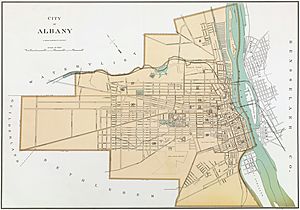
Albany has always been important for transportation. In the early 1800s, it became a center for turnpikes. By 1815, it was the main turnpike center in the state. These roads, along with canals and railroads, made Albany a key stop for pioneers traveling west.
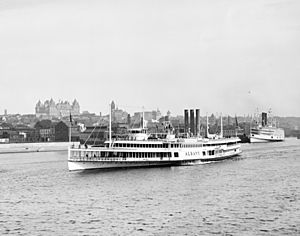
In 1807, Robert Fulton started the first successful steamboat line from New York City to Albany. By 1810, Albany was the tenth-largest city in the country. In 1825, the Erie Canal was finished. This canal created a water route from the Great Lakes all the way to New York City. The original Erie Canal ended in Albany, making it a very busy port.
Albany also played a big role in rail transport. In 1853, Erastus Corning, a famous businessman and former mayor, combined ten railroads into the New York Central Railroad. One of these was the Mohawk and Hudson Railroad, which was the first successful steam railroad in the country with regular service.
Besides transportation, Albany was also known for its industries. Beer was a big product, thanks to the city's Dutch and German roots. Albany was also a major center for publishing, producing many books. Iron factories brought thousands of immigrants to the city for jobs. By 1865, the Albany Lumber District was the largest lumber market in the nation.
Albany opened one of the first commercial airports in the world in 1908. It moved to its current location in Colonie in 1928 and is now known as Albany International Airport.
Modern Albany: Growth and Change
Erastus Corning 2nd was Albany's mayor from 1942 until his death in 1983. He was one of the longest-serving mayors in U.S. history. During his time, Albany's population decreased as people moved to the suburbs.
Governor Nelson Rockefeller (1959–1973) helped build many new, large government buildings in Albany. This included the Empire State Plaza, SUNY Albany's uptown campus, and the W. Averell Harriman State Office Building Campus. These projects helped keep good jobs in the city.
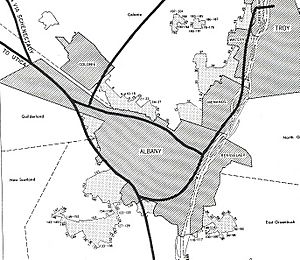
Another big project in the 1960s and 1970s was building Interstate 787. This highway helped connect the city but also separated it from the Hudson River.
When Mayor Corning passed away in 1983, Thomas Whalen became mayor. He worked to restore historic buildings and bring new businesses downtown. He also started more festivals and art events in the city.
In the 1990s, the state government approved the "$234 million Albany Plan." This plan led to many new buildings and renovations downtown. State workers moved from other areas to downtown, helping local businesses. In the early 2000s, the Albany Convention Center was built to host large events.
Today, Albany is an important place for business, especially in Tech Valley. Many large companies have offices here, like American Express and General Electric. Albany has won the All-America City Award twice, in 1991 and 2009.
Geography of Albany: Location and Nature
Albany is about 150 miles (240 km) north of New York City, right on the Hudson River. The city covers about 21.8 square miles (56.8 km2). Most of this is land, with a small part being water.
The city is surrounded by other towns: Colonie to the north, Guilderland to the west, and Bethlehem to the south. There are four lakes within Albany: Buckingham Lake, Rensselaer Lake, Tivoli Lake, and Washington Park Lake.
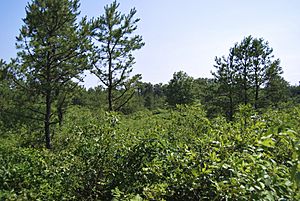
The highest point in Albany is about 378 feet (115 m) above sea level. The lowest point is at the Hudson River, which is only about 2 feet (0.6 m) above sea level at low tide. Albany has rolling hills that were once part of the Albany Pine Bush. This area has sandy soil and special pitch pine and scrub oak trees. The Pine Bush is now a preserve and is home to endangered species like the Karner Blue butterfly.
Albany's Climate: Four Seasons
Albany has a humid continental climate, which means it has four clear seasons. Winters are cold and snowy, while summers are hot and humid. The city gets about 40.7 inches (103 cm) of rain and snow each year. Snowfall is significant, with about 59.4 inches (151 cm) per season.
Temperatures can drop to 0°F (-18°C) or lower about nine nights a year. Summers can have hot and humid days, with temperatures reaching 90°F (32°C) or higher about nine days a year. The coldest temperature ever recorded was -28°F (-33°C) in 1971, and the hottest was 104°F (40°C) in 1911.
| Climate data for Albany International Airport, New York (1991–2020 normals, extremes 1874–present ) | |||||||||||||
|---|---|---|---|---|---|---|---|---|---|---|---|---|---|
| Month | Jan | Feb | Mar | Apr | May | Jun | Jul | Aug | Sep | Oct | Nov | Dec | Year |
| Record high °F (°C) | 71 (22) |
74 (23) |
89 (32) |
93 (34) |
97 (36) |
100 (38) |
104 (40) |
102 (39) |
100 (38) |
91 (33) |
82 (28) |
72 (22) |
104 (40) |
| Mean maximum °F (°C) | 55 (13) |
54 (12) |
66 (19) |
81 (27) |
88 (31) |
92 (33) |
93 (34) |
91 (33) |
87 (31) |
78 (26) |
68 (20) |
56 (13) |
95 (35) |
| Mean daily maximum °F (°C) | 32.8 (0.4) |
36.0 (2.2) |
45.3 (7.4) |
59.2 (15.1) |
71.2 (21.8) |
79.4 (26.3) |
83.9 (28.8) |
82.0 (27.8) |
74.4 (23.6) |
61.6 (16.4) |
49.3 (9.6) |
38.2 (3.4) |
59.4 (15.2) |
| Daily mean °F (°C) | 24.4 (−4.2) |
26.8 (−2.9) |
35.7 (2.1) |
48.1 (8.9) |
59.6 (15.3) |
68.4 (20.2) |
73.1 (22.8) |
71.4 (21.9) |
63.5 (17.5) |
51.4 (10.8) |
40.5 (4.7) |
30.4 (−0.9) |
49.4 (9.7) |
| Mean daily minimum °F (°C) | 15.9 (−8.9) |
17.6 (−8.0) |
26.1 (−3.3) |
36.9 (2.7) |
48.1 (8.9) |
57.4 (14.1) |
62.4 (16.9) |
60.7 (15.9) |
52.6 (11.4) |
41.1 (5.1) |
31.6 (−0.2) |
22.7 (−5.2) |
39.4 (4.1) |
| Mean minimum °F (°C) | −6 (−21) |
−2 (−19) |
8 (−13) |
24 (−4) |
34 (1) |
43 (6) |
52 (11) |
49 (9) |
38 (3) |
27 (−3) |
16 (−9) |
5 (−15) |
−8 (−22) |
| Record low °F (°C) | −28 (−33) |
−22 (−30) |
−21 (−29) |
9 (−13) |
26 (−3) |
35 (2) |
40 (4) |
34 (1) |
24 (−4) |
16 (−9) |
−11 (−24) |
−22 (−30) |
−28 (−33) |
| Average precipitation inches (mm) | 2.60 (66) |
2.28 (58) |
3.09 (78) |
3.11 (79) |
3.41 (87) |
4.05 (103) |
4.55 (116) |
3.76 (96) |
3.73 (95) |
3.85 (98) |
2.99 (76) |
3.26 (83) |
40.68 (1,033) |
| Average snowfall inches (cm) | 15.6 (40) |
13.7 (35) |
12.0 (30) |
1.6 (4.1) |
0.1 (0.25) |
0.0 (0.0) |
0.0 (0.0) |
0.0 (0.0) |
0.0 (0.0) |
0.3 (0.76) |
2.6 (6.6) |
13.3 (34) |
59.2 (150) |
| Average precipitation days (≥ 0.01 in) | 12.7 | 10.6 | 11.8 | 12.2 | 12.7 | 12.2 | 11.4 | 11.0 | 9.7 | 11.2 | 11.1 | 12.6 | 139.2 |
| Average snowy days (≥ 0.1 in) | 10.1 | 7.8 | 5.7 | 1.3 | 0.0 | 0.0 | 0.0 | 0.0 | 0.0 | 0.2 | 2.4 | 7.0 | 34.5 |
| Average relative humidity (%) | 71.1 | 68.5 | 64.8 | 61.2 | 65.5 | 69.5 | 70.5 | 74.1 | 75.7 | 72.4 | 73.1 | 73.9 | 70.0 |
| Average dew point °F (°C) | 12.9 (−10.6) |
14.5 (−9.7) |
22.6 (−5.2) |
32.2 (0.1) |
45.0 (7.2) |
55.0 (12.8) |
60.3 (15.7) |
59.4 (15.2) |
52.3 (11.3) |
40.3 (4.6) |
31.1 (−0.5) |
19.4 (−7.0) |
37.1 (2.8) |
| Mean monthly sunshine hours | 141.1 | 158.5 | 200.3 | 218.9 | 248.9 | 262.2 | 289.2 | 253.2 | 210.5 | 168.8 | 100.7 | 108.3 | 2,360.6 |
| Percent possible sunshine | 48 | 54 | 54 | 54 | 55 | 57 | 62 | 59 | 56 | 49 | 34 | 38 | 53 |
| Average ultraviolet index | 1 | 2 | 4 | 5 | 7 | 8 | 8 | 7 | 6 | 3 | 2 | 1 | 5 |
| Source 1: NOAA (relative humidity, dew point, and sun 1961–1990) | |||||||||||||
| Source 2: Weather Atlas | |||||||||||||
Cityscape: How Albany Looks
Albany's Neighborhoods
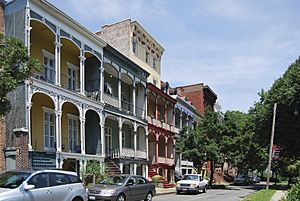
Albany has many different neighborhoods. Some popular ones include Arbor Hill, Center Square (which has a mix of homes and businesses), Pine Hills, and the South End.
People of Albany: A Diverse Community
| Historical population | |||
|---|---|---|---|
| Census | Pop. | %± | |
| 1790 | 3,498 | — | |
| 1800 | 5,349 | 52.9% | |
| 1810 | 10,762 | 101.2% | |
| 1820 | 12,630 | 17.4% | |
| 1830 | 24,209 | 91.7% | |
| 1840 | 33,721 | 39.3% | |
| 1850 | 50,763 | 50.5% | |
| 1860 | 62,367 | 22.9% | |
| 1870 | 69,422 | 11.3% | |
| 1880 | 90,758 | 30.7% | |
| 1890 | 94,923 | 4.6% | |
| 1900 | 94,151 | −0.8% | |
| 1910 | 100,253 | 6.5% | |
| 1920 | 113,344 | 13.1% | |
| 1930 | 127,412 | 12.4% | |
| 1940 | 130,577 | 2.5% | |
| 1950 | 134,995 | 3.4% | |
| 1960 | 129,726 | −3.9% | |
| 1970 | 115,781 | −10.7% | |
| 1980 | 101,727 | −12.1% | |
| 1990 | 101,082 | −0.6% | |
| 2000 | 95,658 | −5.4% | |
| 2010 | 97,856 | 2.3% | |
| 2020 | 99,224 | 1.4% | |
| 2023 (est.) | 101,228 | 3.4% | |
| Sources: 1790–1950, 1960–1980, 1990–2000 2010–2020 |
|||
Albany has always been a city with many different kinds of people. It started with the Mohican and Mohawk people, then Dutch and Germans. Later, the British became the main group.
In the 1800s, many Irish immigrants came to Albany, especially during the Great Famine in the 1840s. Later, Polish and Italian immigrants also arrived. The Jewish community also grew a lot in the late 1800s.
In the mid-to-late 1900s, many African Americans moved to Albany from the southern United States as part of the Great Migration. They came for jobs and new opportunities. In 1950, African Americans were 3% of the population, but by 2010, they were 30%. This change happened as many middle-class white families moved to the suburbs.
Since 2007, many Burmese refugees, especially from the Karen ethnic group, have moved to Albany. By 2015, about 5,000 Burmese refugees lived in the city.
Religious Life in Albany
Albany has many different religious groups, including Orthodox Christian, Roman Catholic, Protestant, and Jewish communities. The First Church in Albany (Reformed), founded in 1642, is the second-oldest Reformed Church in America. The Cathedral of the Immaculate Conception is the main church for the Roman Catholic Diocese of Albany. The Cathedral of All Saints is the main church for the Episcopal Diocese of Albany.
A Jewish community has been in Albany since 1658. Today, Albany has several synagogues, including Conservative, Chabad-Lubavitch, Orthodox, and Reform synagogues. There is also one of the few Karaite synagogues outside Israel.
The Muslim population in Albany has grown since the late 2000s, with many refugees from countries like Iraq, Syria, and Afghanistan arriving. There are at least four major mosques in the area.
Economy of Albany: Jobs and Innovation
Albany's economy relies heavily on government jobs, health care, education, and, more recently, technology. Because these jobs are usually stable, Albany's economy has not been hit as hard by national economic recessions. In 2009, over 25% of the city's population worked in government jobs.
Tech Valley: A Growing High-Tech Hub
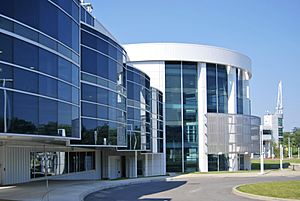
Since the 2000s, Albany and the surrounding Capital District have become a center for high technology. This area is known as Tech Valley. It was named in 1998 to show that the Albany area can compete with other tech hubs like Silicon Valley.
Tech Valley has many schools focused on technology, like Rensselaer Polytechnic Institute and the State University of New York Polytechnic Institute. The area has seen a lot of growth in computer hardware, especially in nanotechnology and microchip manufacturing. There's also a growing group of video game developers in Albany.
Arts and Culture in Albany: Fun Things to Do
Nightlife and Entertainment
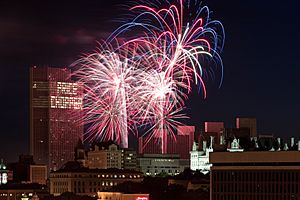
Albany is a good stop for touring artists because it's about halfway between New York City and Montreal. The Palace Theatre and The Egg host music, theater, and spoken-word shows. The MVP Arena is the biggest place for concerts and other large events.
The city has worked to create areas with lots of restaurants, clubs, and bars. Madison Avenue, Pearl Street, Delaware Avenue, and Lark Street are popular entertainment spots. Many old buildings have been brought back to life as new businesses.
Festivals and Events
Alive at 5 is a free concert series held downtown on Thursdays during the summer. The Tulip Festival celebrates Albany's Dutch heritage in Washington Park. Thousands of tulips bloom in early May, and many people attend.

The Capital Pride Parade and Festival is a big gay pride event held every June, attracting about 30,000 people. The Price Chopper Fabulous Fourth and Fireworks Festival at the Empire State Plaza celebrates Independence Day with music and fireworks. The Freihofer's Run for Women is a 5-kilometer run that brings over 4,000 participants.
Other events include the African American Family Day Arts Festival, Latin Fest, Albany Jazz Festival, and Lark Fest.
Museums and Historic Places
Albany has many museums and historic buildings because of its long history. The New York State Museum, the New York State Library, and the New York State Archives are all located in the Cultural Education Center at the Empire State Plaza. They are free to visit.
The USS Slater (DE-766), a World War II ship, is a museum ship docked in the Hudson River. It's the only ship of its kind still floating. The Albany Heritage Area Visitors Center has a museum and the Henry Hudson Planetarium. The Irish American Heritage Museum opened in 2012 and shows the contributions of Irish people in America.
The Albany Institute of History and Art collects and shares the history and art of Albany and the Upper Hudson Valley. It has a large collection of paintings and an exhibit on Ancient Egypt with mummies.
Albany has 57 places listed on the National Register of Historic Places. The Ten Broeck Mansion, built in 1797, is a historic house museum and the home of the Albany County Historical Association.
Literature and Film in Albany
Albany has been featured in many books and movies. Ironweed (1983), a book by Albany native William Kennedy, won a Pulitzer Prize. It was part of his "Albany Cycle" series of books. The film version of Ironweed (1987) starred Jack Nicholson and Meryl Streep and was filmed in Albany.
More recently, downtown Albany was used for filming the movies Salt (starring Angelina Jolie) and The Other Guys (starring Will Ferrell and Mark Wahlberg).
Authors Herman Melville and Henry James lived in Albany when they were young. Gregory Maguire, who wrote Wicked: The Life and Times of the Wicked Witch of the West (which became the musical Wicked), grew up in North Albany.
Architecture of Albany: Buildings and Design
The Empire State Plaza is a group of state office buildings that you can see from almost anywhere in Albany. It was built between 1965 and 1978 and is a strong example of modern architecture. The Erastus Corning Tower in the Plaza is the tallest building in New York outside of New York City. At the north end of the Plaza is the 19th-century New York State Capitol, where the state government meets.
Albany's early buildings showed a lot of Dutch and English styles. The Quackenbush House, built around 1736, is a Dutch Colonial brick house. The Schuyler Mansion, built in 1765, is a Georgian-style mansion. The oldest building in Albany is the 1728 Van Ostrande-Radliff House.
Albany City Hall, designed by Henry Hobson Richardson, opened in 1883. The New York State Capitol opened in 1899 and was very expensive to build. Albany's Union Station, a beautiful Beaux-Arts building, opened in 1900. The New York State Department of Education Building, with its white marble columns, opened in 1912. The 1920s brought Art Deco style, seen in buildings like the Home Savings Bank Building.
Buildings from the 1960s and 1970s are also common, especially at the W. Averell Harriman State Office Building Campus and the uptown campus of the University at Albany. The SUNY Albany campus has a unique design with central buildings surrounded by four student housing towers.
Downtown Albany has been revitalized in recent decades. The MVP Arena opened in 1990. Other new buildings and projects have helped bring life back to the downtown area.
Sports in Albany: Teams and Games
Albany has professional sports teams in three major leagues: the Albany FireWolves (lacrosse), New York Atlas (lacrosse), and Albany Firebirds (arena football).
The Albany Devils were a minor league ice hockey team that played in the city from 2010 to 2017. They were connected to the New Jersey Devils of the National Hockey League.
The Times Union Center has hosted arena football teams like the Albany Firebirds (1990-2000) and the Albany Empire (2018-2019). A new Albany Empire started in 2021, and a relaunched Albany Firebirds began playing in 2024.
The Tri-City ValleyCats are a minor league baseball team that plays in nearby North Greenbush. The Albany Patroons basketball team has played in Albany on and off since 1982.
College sports are also very popular. The University at Albany's Great Danes play at the Division I level. The Siena Saints men's basketball team gained popularity after making it to the NCAA Tournament several times. Siena's campus is in Colonie, but their basketball team plays at the Times Union Center.
Albany also hosted the New York Giants training camp from 1996 to 2012.
Parks and Recreation in Albany: Green Spaces and Fun
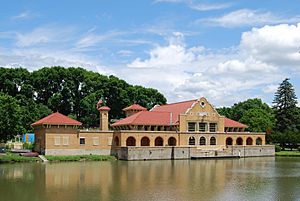
Albany has over 60 public parks and recreation areas. Washington Park was designed in 1870 and opened in 1871. It's a popular place for exercise, sports, ice skating in winter, and attending plays in the summer. It's also where the Tulip Fest is held.
Other parks include Lincoln Park, which has a pool, and Buckingham Lake Park, with a pond and playground. The Albany Riverfront Park at the Corning Preserve has an amphitheater for events and a bike trail. The Albany Pine Bush preserve is on the city's western edge.
Albany also has the municipal golf course, New Course at Albany, which was built in 1929.
Education in Albany: Schools and Colleges
The City School District of Albany (CSDA) runs the city's public schools, which include 17 schools and learning centers. There are also 7 charter schools. In the 2015–2016 school year, over 9,000 students were in public schools. Albany High was listed as one of the nation's best high schools in a 2010 Newsweek/Washington Post report.
Albany also has several private schools, like Bishop Maginn High School, Albany Academy (for boys), and Academy of the Holy Names (for girls).
Albany has many colleges and universities. Albany Medical College was founded in 1839. Albany Law School is the oldest law school in New York. The Albany College of Pharmacy and Health Sciences is the second-oldest pharmacy school in New York.
The New York State Normal School, one of the oldest teacher colleges, opened in 1844. It later became the University at Albany, also known as SUNY Albany. Other colleges include Empire State College, The College of Saint Rose, and Excelsior College. These colleges bring many students to the city.
Media in Albany: News and Entertainment
The Times Union is Albany's main daily newspaper. Other newspapers that serve the area include The Daily Gazette from Schenectady and The Record from Troy. Metroland is an alternative newsweekly.
The Albany-Schenectady-Troy area is an important place for radio and television. WRGB was the first station-based television station. The area also had the first independently owned commercial FM radio station. Today, Albany has many TV stations, including ABC, CBS, Fox, and NBC affiliates. Spectrum News Capital Region is the area's only local 24-hour news channel.
Transportation in Albany: Getting Around
Highways
The New York State Thruway is the most important highway in Albany. To the west, it's part of Interstate 90, connecting to cities like Syracuse and Buffalo. To the south, it's part of Interstate 87, leading to New York City. North of Albany, Interstate 87 goes all the way to Canada. Interstate 787 connects downtown Albany to these major highways.
Trains
Passenger train service is provided by Amtrak at the Albany-Rensselaer station, which is across the river in Rensselaer. This station is Amtrak's second-busiest in New York. You can take trains from here to New York City, Montreal, Boston, Chicago, and other cities.
Airport
Albany's main airport is Albany International Airport in Colonie. Major airlines like American Airlines, Delta Air Lines, Southwest Airlines, JetBlue Airlines, and United Airlines offer flights from here.
Bus
The Capital District Transportation Authority (CDTA) provides bus service throughout Albany and the surrounding areas. You can also find long-distance bus services like Greyhound Lines and Megabus at a downtown terminal.
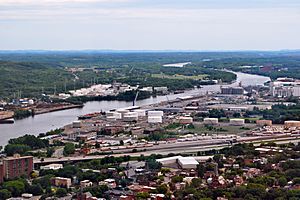
Boat
Albany has always been an important port on the Hudson River. Today, the Port of Albany-Rensselaer serves ships and barges. The New York State Barge Canal, which is the modern version of the Erie Canal, is used by tourist and private boats.
Sister Cities: Connecting with the World
The city of Nijmegen, Netherlands, became a sister city with Albany after World War II. Nijmegen sent Albany 50,000 tulip bulbs in 1948 to thank Albany for helping rebuild its library. This led to the start of Albany's annual Tulip Festival. Most of Albany's other sister city connections were made in the 1980s.
Albany's sister cities are:
See Also
 In Spanish: Albany para niños
In Spanish: Albany para niños
Images for kids
-
Albany, as viewed from the Capitol looking southeast, c. 1906. City Hall is left of center; the twin spires of the Immaculate Conception church can be seen on the far right; the future Empire State Plaza is located at the extreme right of the image.
-
Panorama of Albany and the Hudson River from Rensselaer, looking southwest


